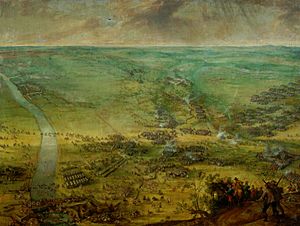Relief of Thionville facts for kids
Quick facts for kids Battle of Thionville |
|||||||
|---|---|---|---|---|---|---|---|
| Part of the Thirty Years' War and the Franco-Spanish War (1635–59) |
|||||||
 The Battle at Deidenhofen (Thionville) 1639, by Peter Snayers |
|||||||
|
|||||||
| Belligerents | |||||||
| Commanders and leaders | |||||||
| Strength | |||||||
| 9,000 infantry 2,600 cavalry |
9,000 infantry 5,000 cavalry |
||||||
| Casualties and losses | |||||||
| 6,000 dead or wounded 3,000 captured |
1,500 dead or wounded | ||||||
The Battle of Thionville happened on June 7, 1639. It was an important fight during the Thirty Years' War, a big conflict that lasted for many years. This battle was about saving the city of Thionville from a siege.
Contents
Why Thionville Was Important
In May 1638, France and the Netherlands attacked the Spanish Netherlands together. This made Spain stop its plans to attack Artois. Even though Spain was fighting on two fronts, its army managed to beat the Dutch at Kallo. Also, the French Siege of Saint-Omer was stopped by armies led by Thomas Francis, Prince of Carignano and Ottavio Piccolomini.
In 1639, France attacked again. They surrounded the city of Hesdin with 14,000 soldiers. At the same time, the French leader Marquis de Feuquieres was told to capture the strong fortress of Thionville. Thionville was very important because it controlled the way into the southern Spanish Netherlands. It also controlled the Moselle Valley, which was a key route. Taking Thionville would also stop the Imperial army from helping their Spanish friends.
The Battle Begins
Feuquieres and his 12,000 French soldiers started to surround Thionville. But early on June 7, an army arrived to help the city. This relief force was led by Piccolomini. It had 5,000 cavalry (soldiers on horseback) and 9,000 infantry (soldiers on foot). This army also included Spanish soldiers led by Jean de Beck.
In the morning, the Imperial and Spanish soldiers attacked the French positions. The fighting stopped for a short time, which allowed the French to get ready. Piccolomini then sent more soldiers into the fortress of Thionville.
Fighting for Control
The Imperial and Spanish forces attacked again in the afternoon. They managed to capture a hill on the left side of the French army. Piccolomini quickly placed his cannons there. From this new position, the Imperial cannons fired on the French cavalry.
Then, the Imperial cavalry, led by Marquis Camillo Gonzaga, charged at the French cavalry. The French cavalry was defeated and chased away. At the same time, the soldiers from inside the Thionville fortress came out and attacked the French army from the side.
The Imperial and Spanish forces surrounded the French infantry and defeated them. They captured all of the French cannons and many supplies. The French army lost about 6,000 soldiers who were killed or wounded. Another 3,000 French soldiers were captured. This included Feuquieres, who later died from his injuries. The winning Imperial-Spanish army lost only about 1,500 soldiers.
What Happened Next
Feuquieres, who was badly hurt, was captured by the Imperial forces and died while he was a prisoner. Because of his great victory, Piccolomini was given the title of Duke of Amalfi by the Spanish King.
Years later, in 1643, another French leader, Duc d'Enghien, won a big battle at Rocroi. After that victory, he moved on to Thionville. The Spanish soldiers inside Thionville fought hard, but the city eventually fell to the French.
See also
 In Spanish: Auxilio de Thionville para niños
In Spanish: Auxilio de Thionville para niños

